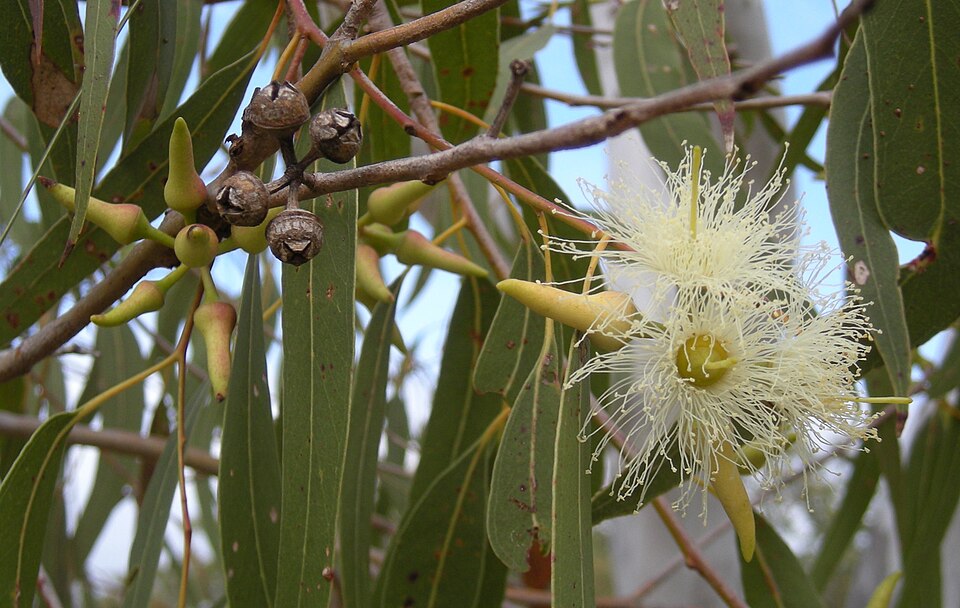Few plants offer both ornamental beauty and medicinal benefit as seamlessly as eucalyptus. With its silvery-green foliage, distinctive aroma, and fast-growing habit, eucalyptus transforms any garden into a calming, aromatic escape. Whether grown for its leaves, oils, or structural presence, it is a plant that radiates resilience and calm.
Used in floral arrangements, herbal remedies, and landscape design, eucalyptus blends utility and grace like few others. With the right site and care, it becomes a commanding yet soothing presence in your garden.

Portrait of the Eucalyptus
Eucalyptus is a woody evergreen tree or shrub in the Myrtaceae family, native to Australia. Known for its aromatic leaves rich in essential oils, it’s widely cultivated for ornamental, medicinal, and forestry purposes.
- Type: Evergreen tree or shrub
- Family: Myrtaceae
- Common Names: Eucalyptus, gum tree, blue gum
Foliage and Form
Eucalyptus features smooth bark, often peeling in strips, and distinctively rounded or lance-shaped leaves that shimmer in silvery hues. Juvenile and mature foliage may differ significantly.
- Height: 6–30 m (20–100 ft), depending on species
- Spread: 4–10 m (13–33 ft)
- Growth Habit: Upright, open canopy; some shrubby species are compact
Blooms and Fragrance
While not primarily grown for flowers, eucalyptus does bloom—its flowers are fluffy, pom-pom-like clusters rich in nectar that attract pollinators.
- Bloom Time: Mid-summer to autumn (varies by species)
- Color: White, cream, pale yellow, or pink
- Fragrance: Leaves are highly aromatic; blooms are subtly sweet
The Right Time to Plant, Flower, and Prune Eucalyptus
| Month | Planting | Flowering | Pruning |
|---|---|---|---|
| January | ❌ | ❌ | ✅ Formative (winter) |
| February | ✅ In mild zones | ❌ | ✅ Light structural cuts |
| March | ✅ Start in pots/outdoors | ❌ | ✅ Training young trees |
| April | ✅ Transplant outdoors | ❌ | ❌ |
| May | ✅ In colder zones | ❌ | ❌ |
| June | ❌ | ✅ (some species begin) | ❌ |
| July | ❌ | ✅ Peak for many | ✅ Light shaping |
| August | ❌ | ✅ Late-season species | ✅ Remove suckers |
| September | ❌ | ✅ (continues) | ✅ Thinning branches |
| October | ✅ Container planting | ✅ (late species) | ❌ |
| November | ✅ (zones 9–10) | ❌ | ✅ Major pruning (dormant) |
| December | ❌ | ❌ | ✅ Cut back for size |
✅ = Recommended ❌ = Not advised
Watering, Sunlight, and Environment for Eucalyptus
Watering
- Eucalyptus prefers deep but infrequent watering once established.
- Young plants need regular moisture to develop strong roots.
When to Water: Weekly in first year; during drought later
How Much: Deep soak at base
Watch Out For: Overwatering in clay soils
Sunlight
- Eucalyptus thrives in full sun, and insufficient light leads to leggy growth and sparse foliage.
Ideal Exposure: 6–8 hours of direct sun daily
Shade Tolerance: Minimal—sun-loving plant
Indoor vs Outdoor
- Eucalyptus is best suited to outdoor conditions due to its size and light needs.
- However, dwarf varieties (like Eucalyptus gunnii ‘Azura’) can be grown in large pots.
Best Location: Garden beds, large containers, open areas
Avoid: Small indoor pots or shaded patios
Temperature
- Eucalyptus can be hardy, depending on the species. Some tolerate mild frost; others require warm, sheltered zones.
Optimal Range: 15–30°C (59–86°F)
Hardiness Zones: Varies; many suited to USDA 8–11
Protection Tip: Mulch base in winter in borderline zones
Ideal Soil Conditions for Growing Eucalyptus
| Soil Feature | Optimal Condition | Why It Matters |
|---|---|---|
| Soil Type | Sandy loam | Encourages root spread and quick drainage |
| Texture | Light, crumbly | Reduces risk of compaction |
| Drainage | Well-draining | Prevents root rot, essential for Mediterranean plants |
| Moisture | Moderate to dry once established | Eucalyptus is drought-tolerant once mature |
| Soil pH | Slightly acidic to neutral (6.0–7.5) | Broad tolerance, but best growth in mid range |
| Fertility | Low to moderate | Too much fertilizer causes fast, weak growth |
Common Problems & Solutions
| Issue 🐾 | Symptoms 🔍 | Solutions 🛠️ |
|---|---|---|
| Leaf drop 🍃 | Sudden yellowing or shedding | Temporary shock; water consistently |
| Root rot 💧 | Wilting, blackened roots | Improve drainage, reduce watering |
| Powdery mildew 🌫️ | White film on leaves | Increase airflow, apply fungicide |
| Wind damage 💨 | Broken branches, leaning trunk | Stake young trees, prune for strong structure |
| Sucker growth 🌱 | Excess shoots from base | Remove regularly to promote healthy growth |
Eucalyptus brings a striking silhouette, captivating scent, and low-maintenance charm to the garden. Whether grown for its leaves, shade, or structure, it remains a standout addition—especially in drought-tolerant or Mediterranean landscapes. With mindful planting and light shaping, it will stand tall and fragrant for years to come.